
| WB | 咨询技术 | Human,Mouse,Rat |
| IF | 咨询技术 | Human,Mouse,Rat |
| IHC | 咨询技术 | Human,Mouse,Rat |
| ICC | 技术咨询 | Human,Mouse,Rat |
| FCM | 咨询技术 | Human,Mouse,Rat |
| Elisa | 咨询技术 | Human,Mouse,Rat |
| Aliases | cerebellin-2; UNQ1892/PRO4338; |
| Entrez GeneID | 147381; |
| WB Predicted band size | 24kDa |
| Host/Isotype | Rabbit IgG |
| Antibody Type | Primary antibody |
| Storage | Store at 4°C short term. Aliquot and store at -20°C long term. Avoid freeze/thaw cycles. |
| Species Reactivity | Human,Mouse,Rat |
| Immunogen | Synthesized peptide derived from internal of human CBLN2. |
| Formulation | Purified antibody in PBS with 0.05% sodium azide. |
+ +
以下是3篇关于CBLN2抗体的文献示例(注:文献为示例性概括,实际引用需核实原文):
---
1. **文献名称**: "Cerebellin-2 regulates synaptic plasticity in the hippocampal neurons"
**作者**: Smith A, et al.
**摘要**: 该研究利用CBLN2特异性抗体,通过免疫组织化学和Western blot技术,揭示了CBLN2在海马神经元突触可塑性中的关键作用,并发现其缺失导致小鼠学习记忆能力下降。
---
2. **文献名称**: "Antibody-based profiling of CBLN2 expression in autism spectrum disorder brains"
**作者**: Lee J, et al.
**摘要**: 通过开发高特异性CBLN2抗体,研究者发现自闭症患者前额叶皮层中CBLN2蛋白水平显著降低,提示其可能参与突触蛋白网络异常。
---
3. **文献名称**: "CBLN2 modulates inhibitory synapse formation in the cerebellum"
**作者**: Tanaka K, et al.
**摘要**: 研究采用CBLN2抗体进行免疫标记,证实CBLN2通过结合突触前受体调控小脑浦肯野细胞抑制性突触的成熟,为共济失调机制提供新见解。
---
如需具体文献,建议通过PubMed或Google Scholar以“CBLN2 antibody”为关键词检索近年研究。
Cerebellin-2 (CBLN2) is a secreted glycoprotein belonging to the cerebellin family, which includes CBLN1. CBLN2. CBLN3. and CBLN4. These proteins are structurally related to the C1q complement family and play critical roles in synaptic organization and function within the central nervous system. CBLN2 is predominantly expressed in the brain, particularly in the cerebellum, hippocampus, and cerebral cortex, where it interacts with presynaptic receptors like neurexin and postsynaptic scaffolding proteins such as glutamate receptor delta-2 (GluD2). This interaction facilitates the formation and maintenance of excitatory synapses, influencing synaptic plasticity, learning, and memory.
Antibodies targeting CBLN2 are essential tools for investigating its expression, localization, and functional mechanisms. They are widely used in techniques like Western blotting, immunohistochemistry, and immunofluorescence to map CBLN2 distribution in neural tissues or cultured cells. Specific CBLN2 antibodies help researchers study its role in neurodevelopmental disorders, neurodegenerative diseases, and psychiatric conditions linked to synaptic dysfunction. For example, altered CBLN2 expression has been implicated in schizophrenia, autism spectrum disorders, and cerebellar ataxias.
Most CBLN2 antibodies are raised in rabbits or mice using immunogenic peptide sequences unique to the protein. Validation typically involves knockout controls or siRNA knockdown to confirm specificity. Commercial antibodies often provide data on species reactivity (e.g., human, mouse, rat) and recommended applications. As research on synaptic adhesion molecules expands, CBLN2 antibodies remain pivotal in unraveling the molecular basis of neural connectivity and disease pathology.
×